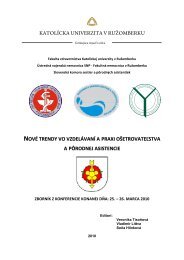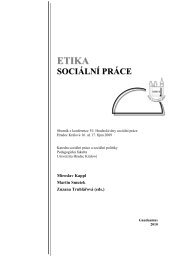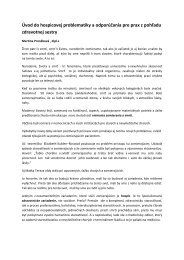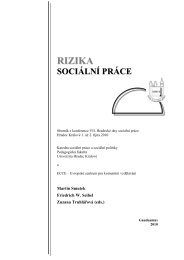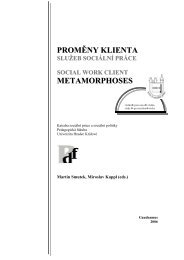Zmena klÃmy â možný dopad (nielen) na obyvateľstvo - Prohuman
Zmena klÃmy â možný dopad (nielen) na obyvateľstvo - Prohuman
Zmena klÃmy â možný dopad (nielen) na obyvateľstvo - Prohuman
Create successful ePaper yourself
Turn your PDF publications into a flip-book with our unique Google optimized e-Paper software.
of the central nervous system. Although many HIV-related infections only occur<br />
in the advanced stages of the disease, bacterial infections can occur at any time.<br />
Bacterial pneumonia and Salmonella foodborne infections are particularly<br />
common problems for AIDS patients. Bacterial pneumonia is often the first sign<br />
of HIV. When caused by penicillin-resistant bacteria, the mortality rate for AIDS<br />
patients is approximately 7.8 times higher compared to infections caused by bacteria<br />
that are fully or even partially sensitive to penicillin.<br />
HIV-infected patients are also at greater risk of developing serious foodborne<br />
bacterial infections. In the 1980’s, persistent infection with Salmonella was identified<br />
as one of the infections defining AIDS. Unlike healthy persons who usually<br />
require no therapy for Salmonella, AIDS patients need to take antibiotics daily to<br />
prevent recurrent infection of the bloodstream (septicemia). Several other bacterial<br />
infections also plague these patients. Worldwide, bacterial infections are<br />
a principal cause of death in AIDS patients, with antibiotic-resistant infections<br />
posing a particular threat. Protecting the efficacy of these antibiotic drugs is critical<br />
in maintaining treatment options for these infections in persons living with<br />
HIV/AIDS. Although careful use of antibiotics can result in the emergence of antibiotic-resistant<br />
bacteria, i<strong>na</strong>ppropriate use greatly accelerates this process. The<br />
more often bacteria are exposed to antibiotics, the more resistant they become.<br />
Because bacteria reproduce rapidly, these antibiotic-resistant bacteria can spread<br />
efficiently. Unlike higher organisms, bacteria can transfer DNA to other bacteria<br />
that are not their offspring, and even to members of completely unrelated bacterial<br />
species. In effect, bacteria can teach one another how to outwit antibiotics.<br />
Antibiotic resistance carries a significant economic toll as well as a medical one.<br />
The congressio<strong>na</strong>l Office of Technology Assessment calculated that resistance in<br />
just six types of bacteria increased hospital treatment costs by $2.7 billion as of<br />
2006. Few new drugs are now in the pipeline, and any new antibiotics will be<br />
considerably more expensive than existing ones; the research and development<br />
costs for a new drug may top $800 million, while prescription costs are likely to<br />
far exceed those for older, generic medicines. Although the misuse of antibiotics<br />
in human medicine has been well publicized, less attention has been paid to the<br />
serious overuse of antibiotics in agriculture. By one estimate, 80 percent of all<br />
antibiotics and related drugs (antimicrobials) sold in the United States are used<br />
in livestock production. The lion’s share-roughly 70 percent of the total-are fed<br />
to healthy farm animals to promote growth and prevent diseases that would otherwise<br />
result from the unsanitary conditions found in overcrowded agricultural<br />
facilities. About half of those drugs are identical or closely related to medicines<br />
used in treating humans.<br />
55





